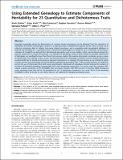| dc.contributor.author | Zaitlen, Noah | |
| dc.contributor.author | Kraft, Peter | |
| dc.contributor.author | Patterson, Nick | |
| dc.contributor.author | Pasaniuc, Bogdan | |
| dc.contributor.author | Bhatia, Gaurav | |
| dc.contributor.author | Pollack, Samuela | |
| dc.contributor.author | Price, Alkes L. | |
| dc.date.accessioned | 2013-08-22T13:38:29Z | |
| dc.date.available | 2013-08-22T13:38:29Z | |
| dc.date.issued | 2013-05 | |
| dc.date.submitted | 2012-09 | |
| dc.identifier.issn | 1553-7404 | |
| dc.identifier.issn | 1553-7390 | |
| dc.identifier.uri | http://hdl.handle.net/1721.1/79913 | |
| dc.description.abstract | Important knowledge about the determinants of complex human phenotypes can be obtained from the estimation of heritability, the fraction of phenotypic variation in a population that is determined by genetic factors. Here, we make use of extensive phenotype data in Iceland, long-range phased genotypes, and a population-wide genealogical database to examine the heritability of 11 quantitative and 12 dichotomous phenotypes in a sample of 38,167 individuals. Most previous estimates of heritability are derived from family-based approaches such as twin studies, which may be biased upwards by epistatic interactions or shared environment. Our estimates of heritability, based on both closely and distantly related pairs of individuals, are significantly lower than those from previous studies. We examine phenotypic correlations across a range of relationships, from siblings to first cousins, and find that the excess phenotypic correlation in these related individuals is predominantly due to shared environment as opposed to dominance or epistasis. We also develop a new method to jointly estimate narrow-sense heritability and the heritability explained by genotyped SNPs. Unlike existing methods, this approach permits the use of information from both closely and distantly related pairs of individuals, thereby reducing the variance of estimates of heritability explained by genotyped SNPs while preventing upward bias. Our results show that common SNPs explain a larger proportion of the heritability than previously thought, with SNPs present on Illumina 300K genotyping arrays explaining more than half of the heritability for the 23 phenotypes examined in this study. Much of the remaining heritability is likely to be due to rare alleles that are not captured by standard genotyping arrays. | en_US |
| dc.language.iso | en_US | |
| dc.publisher | Public Library of Science | en_US |
| dc.relation.isversionof | http://dx.doi.org/10.1371/journal.pgen.1003520 | en_US |
| dc.rights | Creative Commons Attribution | en_US |
| dc.rights.uri | http://creativecommons.org/licenses/by/2.5/ | en_US |
| dc.source | PLoS | en_US |
| dc.title | Using Extended Genealogy to Estimate Components of Heritability for 23 Quantitative and Dichotomous Traits | en_US |
| dc.type | Article | en_US |
| dc.identifier.citation | Zaitlen, Noah, Peter Kraft, Nick Patterson, Bogdan Pasaniuc, Gaurav Bhatia, Samuela Pollack, and Alkes L. Price. “Using Extended Genealogy to Estimate Components of Heritability for 23 Quantitative and Dichotomous Traits.” Edited by Peter M. Visscher. PLoS Genetics 9, no. 5 (May 30, 2013): e1003520. | en_US |
| dc.contributor.department | Whitaker College of Health Sciences and Technology | en_US |
| dc.contributor.mitauthor | Bhatia, Gaurav | en_US |
| dc.relation.journal | PLoS Genetics | en_US |
| dc.eprint.version | Final published version | en_US |
| dc.type.uri | http://purl.org/eprint/type/JournalArticle | en_US |
| eprint.status | http://purl.org/eprint/status/PeerReviewed | en_US |
| dspace.orderedauthors | Zaitlen, Noah; Kraft, Peter; Patterson, Nick; Pasaniuc, Bogdan; Bhatia, Gaurav; Pollack, Samuela; Price, Alkes L. | en_US |
| mit.license | PUBLISHER_CC | en_US |
| mit.metadata.status | Complete | |
